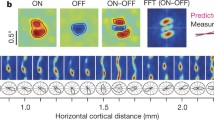Abstract.
The size of a pair of cortical ocular dominance columns determines a basic anatomical module of V-1 which Hubel and Wiesel have termed the hypercolumn. Does this correspond to a basic functional, or psychophysically measurable, module as well? This is the basic question addressed in the present paper. Since the ocular dominance column architecture is presumed to be related to stereo vision, it is natural to assume that hypercolumn size should provide a modular basis for basic phenomena of stereopsis. In previous work, we have suggested that local nonlinear filtering via the cepstral transform, operating on a local window of cortical tissue scaled by hypercolumn size, provides such a modular model of stereopsis. In the present paper, we review this model and then discuss a number of issues related to the biological plausibility and implementation of this algorithm. Then, we present the main result of this paper: we have analyzed a number of experiments related to stereo fusion limits (Panum's area) and to disparity gradient and disparity scaling, and demonstrate that there is a simple unifying explanation for these phenomena in terms of a constant cortical module whose size is determined by a pair of ocular dominance columns. As a corollary, Panum's area must increase according to (inverse) cortical magnification factor. We show that this is supported by all existing experimental data.
Similar content being viewed by others
Explore related subjects
Discover the latest articles and news from researchers in related subjects, suggested using machine learning.Author information
Authors and Affiliations
Additional information
Received: 2 December 1991 / Accepted in revised form: 18 September 1998
Rights and permissions
About this article
Cite this article
Yeshurun, Y., Schwartz, E. Cortical hypercolumn size determines stereo fusion limits. Biol Cybern 80, 117–129 (1999). https://doi.org/10.1007/s004220050510
Issue Date:
DOI: https://doi.org/10.1007/s004220050510




